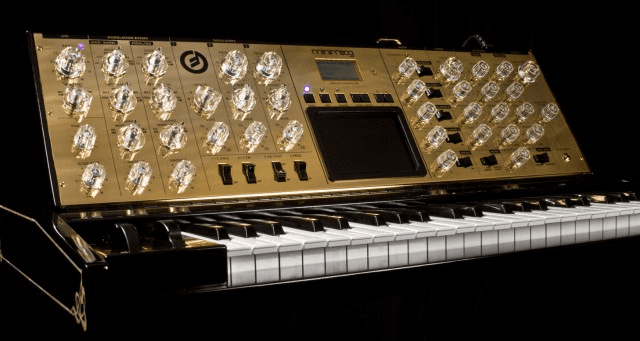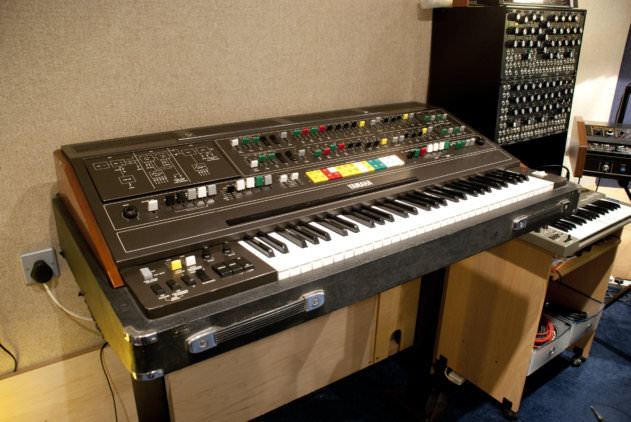Yamaha CS-80
The most expensive vintage polysynth
Estimated value: up to £15,000 in mint condition
There are a handful of almighty polyphonic analogue synths which are universally acknowledged as classics: the Sequential Circuits Prophet-5, the Roland Jupiter-8 and slightly less obvious choices like the Elka Synthex, which Johan Antoni of Syntotek picks out as his holy grail. Perhaps the most desirable of all, however, is the Yamaha CS-80.
Some synths are valuable simply because they were produced in such small numbers that their prices are artificially inflated by their scarcity. That’s not the case here. CS-80s aren’t particularly hard to find; around 2,000 units were sold, and they come up for sale on the second-hand market on a fairly regular basis. Instead, they’re valued simply because of their sound, their features and their impact on the history of electronic music. These are late 70s and early 80s icons of excess, units which have crossed genre boundaries, instruments which top countless producers’ wish lists. As the flagship models of the peak of the analogue era, these are synths which still command jaw-dropping prices. As Vemia’s Peter Forrest puts it: “What makes things valuable in our world is really how much of a buzz there is about them, and because they are uniquely good in some way. The CS-80 offers a combination of amazing analogue polysynth sounds and brilliant user interface.”
Used in the past by the likes of Vangelis (all over the hugely influential Blade Runner soundtrack) and Stevie Wonder (of course), and more recently by Daft Punk, Aphex Twin, Philippe Zdar, RJD2 and Soulwax, the CS-80 is about as close to a dream synth as we can imagine.
The story is perhaps best told by a man who admits to a four-decade ‘love affair’ with the mighty Yamaha. Mark Thompson, owner of London professional audio suppliers Funky Junk and SNAP! Studios, explains his own love affair with the CS-80: “Back in the 1970s, I ran a hire company. In 1977, Yamaha introduced a rather expensive new synthesiser called the CS-80. After much soul-searching, I pooled all my shekels and invested in one. To my amazement, within a few months, the keyboard had pretty much paid for itself, as clients including Rush, Robert Margouleff (producer of Tonto’s Expanding Headband) and others rented the machine non-stop. And in what little time I had to play with it between bookings, it was easy to see why.
“In the formative days of Moog, Oberheim and ARP, the CS-80 went beyond the competition in offering a fully polyphonic eight-voice monster. But it wasn’t just the facilities provided, but the sound itself that made the CS-80 stand out from the polyphonic crowd. This was a truly unique instrument, and could almost be described as a new form of instrument rather than just a variation on a synthetic theme. A bit like a Hammond, the CS-80 was instantly recognisable, producing thick, rich sounds that ebbed and flowed and throbbed with a power and intensity that shone a richness and texture over every track it settled on. Even if pulled right down in a mix, the CS-80 sat solidly in the cut rather than becoming lost as so many other synths of that era (and later) always did.
“In the following years, I managed bands that toured with CS-80s, relying on one keyboard rather than the banks of synths used by most other groups. Properly handled, the CS-80 was all a good keyboard player needed to produce washes and pads and searing solo lines to compliment a variety of rock, soul, pop and ambient music.
“When the chance arose to buy the old PWL CS-80 for SNAP! Studios, I jumped at it, despite finding the 21st-century price tag somewhat intimidating. Because the CS isn’t just another synthesiser, it’s a world unto itself, capable of producing sounds and textures quite unlike any other keyboard ever made. Sure, it’s not a Moog and it’ll never emulate a Prophet-5, but neither can they (or any other synth) come close to the massive, almost overblown power of a CS-80.
“You may never get the chance to spend a stolen night with one of these sexy beasts, but if you do, I suspect that you’ll understand my forty-odd year love affair. Quite simply, the CS-80 is unique. There never was and will never be anything like it.”
The entry price to the exclusive CS-80 owners club? Around £7,000 if you’re lucky. Closer to £15,000 if you’re looking for a mint condition example. Arturia’s CS-80V emulation offers an altogether more affordable option for those of us unwilling to sell a kidney to raise funds.
http://www.youtube.com/watch?v=nbDOl1QHerE


07.09 AM
Fantastically thorough look into the value behind mouth-watering gearporn. Now time to start saving… ;-(
01.26 PM
Didn’t herbie hancock demo that Fairlight sampler on Sesame Street
01.30 PM
He certainly did, alongside a young Tatyana Ali (Ashley from The Fresh Prince Of Bel Air): http://www.youtube.com/watch?v=oKoisNv1ftw
This video of him showing it off to Quincy Jones is also excellent: http://www.youtube.com/watch?v=n6QsusDS_8A
02.35 PM
no Waldorf Wave?!
02.44 PM
The Wave’s definitely right up there with the best of them.
It’d be great to hear all your thoughts on this from a practical perspective too. As amazing as, say, a CS-80 is, would it necessarily be at the top of your shopping list if you won the lottery? We’ve got a feeling a lot of producers are probably more interested in slightly more affordable classics when it comes to actually making music…
12.09 PM
What about the GX1?
05.01 PM
I enjoyed this article as I continue to with Attack’s interviews and insightful cultural articles..
In addition to the vintage/analogue gear, I’d add some modern controllers to the list which have huge expressive capabilities not available on the mass market, such as polyphonic pitchbend and sensing on multiple axes. For example, the Haken Continuum is US$5,290 (without its case or stand). The newly-introduced ROLI Seaboard Grand is US$8,888.88. Those are the prices of decent used cars.
The CS-80 is an curious example of how performance controllers have regressed in some ways in the decades to come. How it takes something like an Arturia Origin (itself US$3,000) to include all those kinds of controllers. Not as much of a price delta change as you’d expect, given progress with home computers.
While some contemporary tech like touchscreens thrive (tablet market demand, thanks iPads!) and the DJ market has seen interesting plays (Maschine’s rise despite doubters re: the Akai dynasty), more specialized-to-music stuff languishes or is still available at very high prices. I figure there needs to be more popular education for new instruments to resolve part of this chicken-and-egg Gordian knot — otherwise most people, clinging onto the familiar piano form, are too scared to transition to it, keeping prices high.
02.44 PM
Great point, Torley. Things like the Continuum and Seaboard are very niche products, but to a certain type of performer or musician they’re truly desirable – partly because there aren’t many alternatives at any price point.
But you also hit on another interesting point. The touchscreen revolution led by the iPad virtually destroyed another product – JazzMutant’s Lemur controller, which eventually returned, slightly ironically, as an iOS app. And that trend for premium products to be replaced by cheaper alternatives is definitely mirrored in other markets – Maschine undercutting the MPCs, Moog introducing the Sub Phatty and dropping the Little Phatty, and so on (that’s without mentioning software, of course).
There really aren’t actually many super high-end synths around any more. There are products like the Prophet 12, SE CODE, Voyager XL, etc, but while the market for budget (<£500) and mid-range (£500-1000) synths seems to be thriving, anything larger is a much riskier proposition for any company.
Dave Smith acknowledged in our interview that the numbers today are much smaller, and that's despite the fact that synths are much cheaper in real terms than they were back in the 70s. Even with today's advances, the question of whether the market for a truly expressive, powerful performance-based synth in the vein of the CS-80 would still exist is open to debate.
03.17 PM
No GXs? No paper face Serge or Music Easel ? No Wave? No Fenix? And no Synthi 100?
12.54 PM
EMS?
05.01 AM
Wow! My CS-80’s “Slave to the Bass” video is posted here. (Blushes). It is a magnificent instrument. I used to sit in front of PBS Cosmos with Carl Sagan for a mind melding experience in the early 80’s after school. Our console TV had a good 6×9 speaker. Never expected to find a CS-80 of my own. I do not believe 2000 were ever made. So far, all functional CS-80’s are between serial numbers 1000-1800. It is believed that less than 800 were made. Cost prohibitive. There are 45 circuit boards, stuffed to the gills. Over 1200 internal trim pots to calibrate.
08.05 PM
https://www.youtube.com/watch?v=5esV1RiIB8o